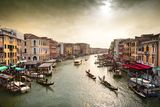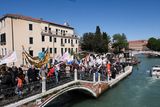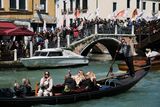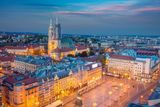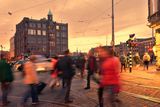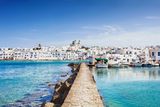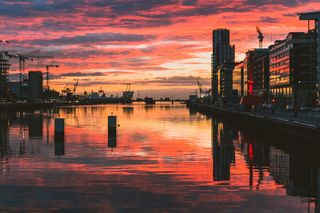Costa Del Crowded: Our favourite holiday destinations are creaking at the seams
Reign of Spain
Tourists are flocking to Spain again amid fears of terror threats elsewhere - but hotspots such as Majorca are struggling to cope with the influx.
Up to 1.5m Irish people will travel to Spain this year on their holidays to bask in the sun. But while the return of the foreign holiday boom is the ultimate sign of economic recovery, many holidaymakers may find that their favourite destinations are creaking at the seams.
There are mounting concerns that hugely popular sunshine destinations such as Majorca and the other Balearic Islands, such as Ibiza and Menorca, have become wildly overcrowded and may be unable to cope with this summer's influx.
The authorities have had to take measures to tackle chronic traffic problems, sea pollution caused by sewage, and water shortages, as the number of tourists arriving continues to grow. From the start of July, visitors to Majorca and the other Balearic Islands will have to pay a 'sustainable tourism tax'. That could cost a family of four up to €85 in an extra bill for a fortnight's holiday.
Even this measure has not deterred visitors. The normal population of the Balearic Islands is just over one million, but by end of the season it will have been swollen by an extra 13m people.
Majorca has long been a favourite haunt of Irish holidaymakers, from families sunbathing and swimming at Santa Ponsa to Leaving Cert students partying all night long in Magaluf.
This year, Irish holidaymakers are likely to find Majorca and other Spanish holiday hotspots more crowded than ever.
The perceived threat of terrorism elsewhere - including Egypt, Tunisia, and Turkey - has caused an extra wave of hundreds of thousands of holidaymakers to descend on Spain.
Pat Dawson, chief executive of the Irish Travel Agents Association (ITAA), says: "It's a changed landscape. The number of tourists going to Turkey, Tunisia and Morocco has fallen dramatically.
"The number of Irish people who would have gone to Turkey and the other countries wasn't huge. The difference now is that many North Europeans such as the Germans went to Turkey. Now they are going to Spain in big numbers."
Dawson expects the number of Irish people going to Spain to increase by 200,000 this year, as foreign holidays return to Celtic Tiger levels.
While many Irish holidaymakers booked early to avail of good value, late bookers have found soaring prices, with flights alone costing up to €500. Late bargains are thin on the ground.
Pat Dawson also predicts a 15pc hike in the cost of winter holidays to destinations such as the Canaries, as holidaymakers switch from the Eastern Mediterranean to other resorts.
On some of the Spanish islands, the authorities are considering measures to curb the build-up of traffic. To avoid gridlock, the islands of Ibiza and Formentera may ban tourists from arriving with their cars.
At the height of the holiday season there are as many as 20,000 cars on Formentera, which is only 19km long.
On Majorca, there are up to 60,000 holiday rental cars at large on the roads, and these are contributing to monster traffic jams.
Gerard Hau of the Balearic environmental group GOB tells Review: "On Majorca, we now have the second highest density of cars in the world after Hong Kong. Because the roads are full, there is a greater risk of accidents."
Adding to the crowds on the Balearic Islands is a surge in the number of cruise ships arriving along the shoreline.
The Observer reported this week that on one day earlier this month, eight cruise ships arrived in the city of Palma, disgorging over 22,000 passengers into buses and taxis as they travelled in the centre of the old town.
With up to 1.5m cruise ship passengers expected in Palma by the end of the season, Biel Barcel, vice-president of the Balearics tourism ministry, has said: "We are encouraging cruise operators to take passengers on excursions to other parts of the island to avoid overcrowding the old town of Palma."
Environmentalist Gerard Hau predicts that some beaches will have to be closed for swimming at times this summer because of sewage pollution.
"Compared to other Mediterranean countries, we have very good sewage management on Majorca, but it has its limits," he said.
"Last year, we had sewage problems in the Bay of Alcudia in the North of the island, and also in Palma sometimes they had to close the beaches because of sewage. This summer, they will probably have to close beaches at times because there will just be too many people on the island."
Hau supports the introduction of the tourism tax, because the money raised will go to environmental projects.
The tax starts at 50 cent per person for each night staying in hostels or camping, and rises to €2 per person over 16 for luxury hotels and apartments. The rate halves once a tourist has stayed for a week. The tax is not included in the price of a holiday, and has to be paid on the ground on the islands.
"It's going to be a big whack for couples with older kids," says Donegal travel agent Cormac Meehan. "You are talking about €85 for a family for a fortnight."
These levies are becoming increasingly common in Spain and elsewhere. Malta is set to impose an "environmental contribution" of 50 cent per night for over-18s.
Barcelona has already taken measures to tackle tourism numbers, with the city council last year putting a cap on the number of licences for visitor accommodation. Visitors also pay a regional tourism tax.
The city has banned large tourist groups from visiting the famous La Boqueria public market at peak times.
While the numbers visiting Majorca is expanding, with planes arriving every two minutes during peak season, Gerard Hau believes this will be temporary, because the infrastructure will not be able to cope.
"I believe the numbers will fall again, because people coming here will be too stressed out.
''They come here to relax, but how can they do that if the buses are full, there are long queues at the airport, and the beaches are overcrowded?"
While Spanish resorts are chock-a-block with visitors, tourism numbers in Turkey have collapsed by 40pc, largely as a result of an exodus by German and Russian visitors.
In January, 12 German tourists were killed in an attack in the historic area of Istanbul. This led to a dramatic fall in bookings. Figures from the Irish Travel Agents Association appear to confirm that our yearning for foreign holidays has returned to Celtic Tiger levels.
The ITAA's Pat Dawson says: "During the boom period there were seven million trips out of Ireland, and we expect that to be exceeded this year."
When Dublin Airport's Terminal 2 was opened in 2010, it was regarded as a white elephant, as the number of foreign trips declined. But now it is extremely busy.
"Without Terminal 2, there would have been chaos at Dublin Airport, and it would have lost a lot of business," says Dawson.
Spain is not the only destination to have seen a surge in the number of Irish holidaymakers. Bookings to Portugal are also described by travel agents as "exceptionally high".
Ireland's participation in Euro 2016 will also bring anything between 15,000 and 20,000 people to France, and the length of the football vacation will depend on the success of our team.
The foreign holiday surge is not necessarily being driven by the same age demographic as the boom during the Celtic Tiger years.
Travel agent Cormac Meehan says: "The market segment that is showing the biggest increase is the mature couple. Families with kids still have a lot of financial constraints."
Travel agents have also noticed that many Irish holidaymakers are exploring other areas away from traditional resorts such as the Costa Del Sol and Benidorm.
"There are new parts of Spain opening up that were previously unknown to Irish tourists. You are finding more Irish people travelling to areas near Jerez on the South coast."
A growing number of Irish holidaymakers are also exploring areas in the north, including the Basque country, and some of the less well-known cities.
Cormac Meehan says prices in northern Spain are likely to be higher this year, because many football fans are basing themselves there for the Euro 16 championship.
"The Spanish product has evolved in recent years. Spain is putting an awful lot of money into tourism promotion," he says.
While the resorts will be swamped with sunseekers, not every corner of Spain will be jam-packed.
Visitors will have to use more imagination to find that spare sun lounger if they do not want it to be booked early by a competing German.
Y VIVA ESPAÑA
1.5m
Irish people are expected to holiday in Spain this year
22,000
cruise passengers came ashore at Palma, Majorca in one day earlier this month
13m
tourists travel to the Balearic Islands every year, with 200,000 going from Ireland
100
flights land in Palma every day
65m
international visitors travel to Spain
60,000
rental cars can be found on the island of Majorca during peak season
€85
tourism tax for a family of four staying for a fortnight on the Balearic Islands
40pc
drop in tourist bookings to Turkey after terror attacks
Join the Irish Independent WhatsApp channel
Stay up to date with all the latest news
